10 Horror Movies That Scarred the Actors in Real Life
From physical injuries to abuse to traumatic experiences, the horror movies on this list had a great toll on actors in real life.
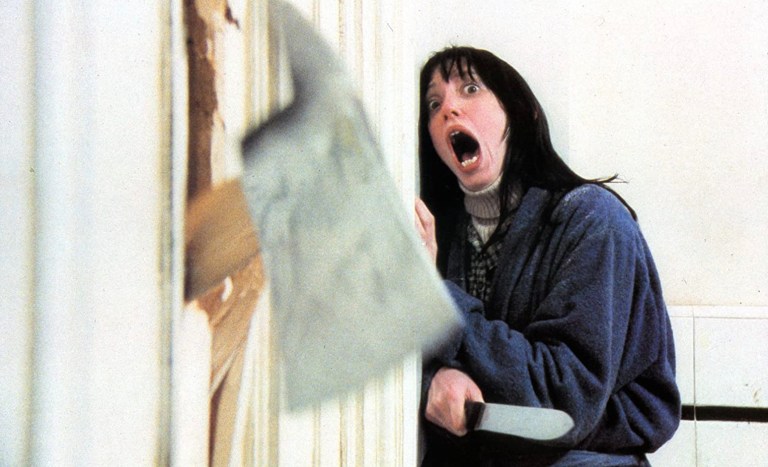
Horror movies can have a lasting impact on the audience. There are films in the genre that stay with us long after the credits roll—movies that terrify us, that have reached some dark corner in our psyche, that have traumatized us, or moved us in some irreversible way. We often think of these films in terms of how they affect us as the viewers. Have you ever wondered how actors get through such disturbing roles?
To put themselves into the psyche of the characters they play must take a severe emotional and psychological toll. The lines between reality and fiction get so blurry that one can’t help but think that they’re left haunted by their intense, demanding work. To some extent, they must endure and feel what their characters do.
Curated below are 10 horror movies that scarred the actors in real life.
Psycho (1960)
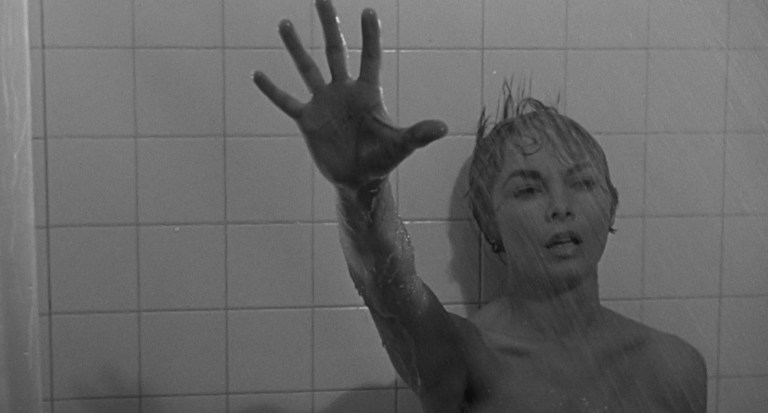
Janet Leigh
Janet Leigh forever carried the horror of the iconic shower scene in Alfred Hitchcock’s Psycho, in which her character Marion Crane is stabbed to death by Norman Bates (Anthony Perkins). At the time of release, the scene was one of the most gruesome to ever appear on screen, shocking viewers everywhere. Leigh was so rattled by the scene that she could no longer take showers after watching it, living the rest of her life opting for baths instead. Leigh shared, “I stopped taking showers and I only take baths. And when I’m someplace where I can only take a shower, I make sure the doors and windows of the house are locked. I also leave the bathroom door open and shower curtain open. I’m always facing the door, watching, no matter where the shower head is.” Leigh also had to deal with stress of receiving constant death threats and menacing phone calls after the movie’s release. Some mail was disturbing enough to have to pass on to the FBI.
The Birds (1963)
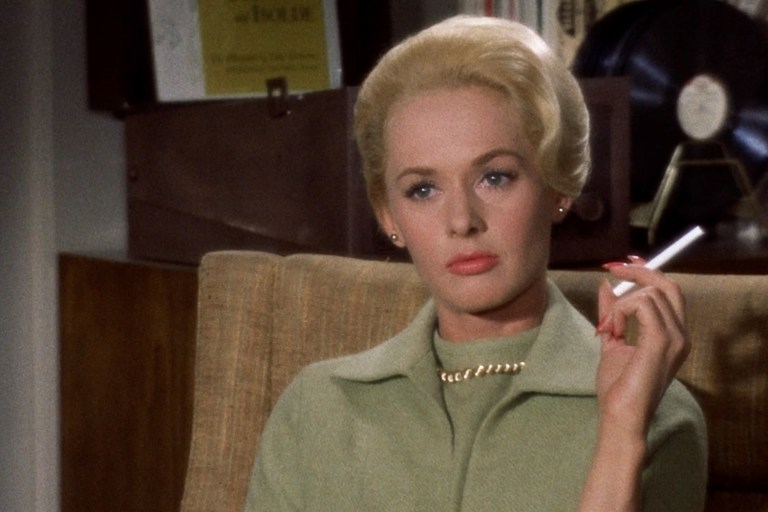
Tippi Hedren
The attic bedroom scene in which Melanie is viciously attacked by birds has a dark story behind how it came to be. Tippi Hedren was duped into believing there would be mechanical birds for the scene, but arrived on set to discover a cage had been built for live birds that were to be used to film the attack. Shot over the course of five days, the scene took a toll on Hedren. The avian creatures, who were trained to peck her, were unleashed on the actor and even tied to her. She described it as “brutal and ugly and relentless.” She finished the scene bloodied, traumatized, and put in a “mental prison” by the director. Her treatment on set was so unbearable that she wanted out of her contract, but Hitchcock threatened to ruin her career, and later prevented her from booking roles. He tormented Hedren over a long period of time through threats, abuse, manipulation, harassment, obsessive behavior, and eventually stalking. In her memoir, Hedren reveals how Hitchcock sexually assaulted her during the filming of both The Birds and Marnie. No amount of prestige can ever wash away the reality of the type of irredeemable man that Hitchcock truly was—a “deviant and evil” tyrant known for his mistreatment of women.
See also: 38 Facts About Alfred Hitchcock’s ‘The Birds’ That You Probably Didn’t Know
The Last House on the Left (1972)
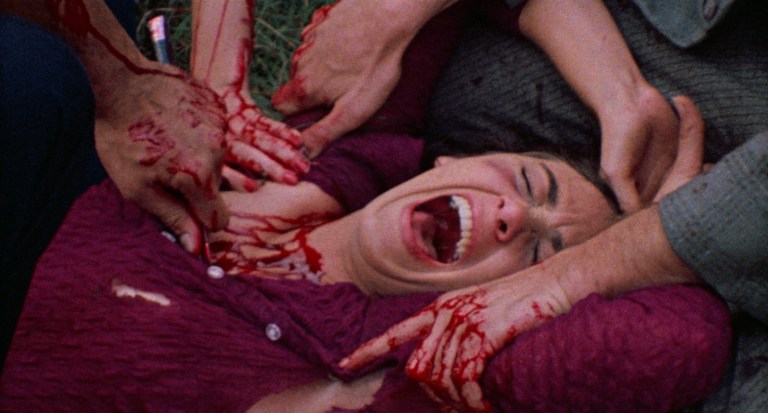
Sandra Peabody
Wes Craven’s rape-and-torture heavy film is so violent it was actually banned in multiple countries. For lead actress Sandra Peabody, whose name was Sandra Cassell at the time, the brutalization was very much real. She suffered great torment at the hands of her male co-stars, who aggressively demeaned, threatened, and harassed her throughout filming. On the film’s commentary track, Marc Sheffler admits to threatening to throw her off a cliff in order to elicit the anxiety needed for a particular scene after many failed takes. He actually threatened to kill her: “If you don’t get this f**king scene right now, I’m going to drop you…and Wes’ll shoot it, and we’ll get a different scene, but it’ll work because you’ll be f**king mangled.” David Hess threatened to assault her to get a strong reaction from her while filming the rape scene. Peabody hasn’t spoken about her experience, but one can only imagine the horror.
The Exorcist (1973)

Ellen Burstyn and Linda Blair
Ellen Burstyn, who played the role of Chirs MacNeil, suffered an injury while working on the legendary horror film The Exorcist. Burstyn was being pulled down by a wire thread in the scene where the demon, in possession of Regan’s body, attacks the mother and knocks her to the ground. After the first take, Burstyn asked Director William Friekdkin and the stuntman not to pull down so hard because she was afraid she’d get hurt, to which the director replied “it has to look real.” Burstyn has shared her suspicions that the director canceled her request behind her back. The stunt man himself has confirmed that he was instructed to “really give it to her this time.” Her cries of pain were in fact very real and not at all acting. She was pulled so violently that she suffered permanent spine damage. Burstyn has shared that instead of yelling cut or helping her, Friedkin kept filming. Friedkin seems to have taken no accountability: “If I hadn’t let the stuntman do that with the force that he did it, she would have had to do it over and over and over again. I would rather have had one take that risked hurting her a little, not injuring her. Yeah, she was hurt. There’s certain things you cannot act, like that sort of hurt.” He declined to ever call it an injury.
Unfortunately, a then 14-year-old Linda Blair also had a similar experience while filming. To shoot the scene where the possessed Regan iconically thrashes on her bed, right before she starts screaming obscenities, Blair was strapped into a rig that would whip her back and forth. The straps on the mechanism loosened while filming, causing a fracture in her lower spine. She still experiences chronic pain as a result, in addition to suffering from scoliosis. In a Cursed FIlms interview on Shudder, Blair said, “I am having my back pounded. I mean, I’m crying, I’m screaming…they think I’m actin’ up a storm.” Her spine injury made it into the final cut of the film.
The Shining (1980)
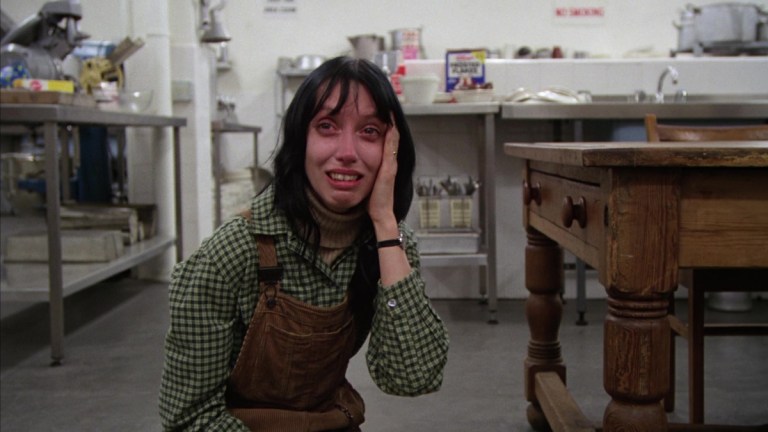
Shelley Duvall
Wendy Torrance was distressed throughout all of The Shining, having to endure an oppressive atmosphere at the Overlook Hotel and an abusive husband who would later turn homicidal. As Wendy unravels on screen, the same was happening to Shelley Duvall in real time. She was put through emotional and psychological torture to be kept at a constant state of anguish and despair. The puffy eyes, the exhaustion, the redness on her face that you see during the baseball bat scene were a result of the brutalization Duvall was experiencing at the hands of the director. He forced her to perform that very scene 127 times.
Working with the director was a process she’d describe as “almost unbearable.” The mental torment was so extreme that Duvall’s hair started falling out. Having to cry every day had its toll: “After a while, your body rebels. It says, ‘Stop doing this to me. I don’t want to cry every day.’ And sometimes just that thought alone would make me cry. To wake up on a Monday morning, so early, and realize that you had to cry all day because it was scheduled—I would just start crying. I’d be like, ‘Oh no, I can’t, I can’t.’ And yet I did it. I don’t know how I did it.” Kubrick intentionally isolated her from the cast and crew to heighten her character’s sense of isolation, and encouraged everyone on set to ignore her. Although Duvall doesn’t seem to hold any hard feelings toward Kubrick, it cannot be denied that what she was put through was abuse for the sake of creating art.
See also: Stanley Kubrick Movies: Cinema’s Ultimate Perfectionist
Possession (1981)
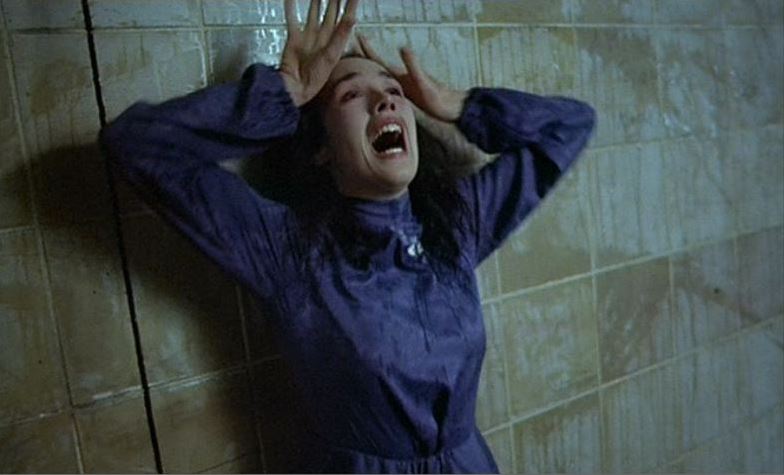
Isabelle Adjani
Possession star Isabelle Adjani was electric as Anna, a woman come undone and increasingly histrionic. Her performance won her a Best Actress award at Cannes, but it came at a high cost. Adjani has shared that it took her years to recover from the intense role, which was emotionally and mentally draining. The actor suffered a breakdown after watching a finished cut of the film that drove her to try to cut her wrists, a suicide attempt which has been confirmed by director Andrzej Żuławski. Adjani has spoken up about the lingering trauma of shooting the legendary horror film: “I often wonder, when a person is an actress, if they’re capable of overcoming everything that’s inflicted on them. I remember—if you’ll allow me to offer a comparison from my own career and some situations with the director Andrzej Żuławski—there was something of great violence that I agreed to take on. But I’ve realized over the years that it’s something I could never accept again, and it’s part of everything that my subconscious has been swallowing and incubating.”
The Blair Witch Project (1999)
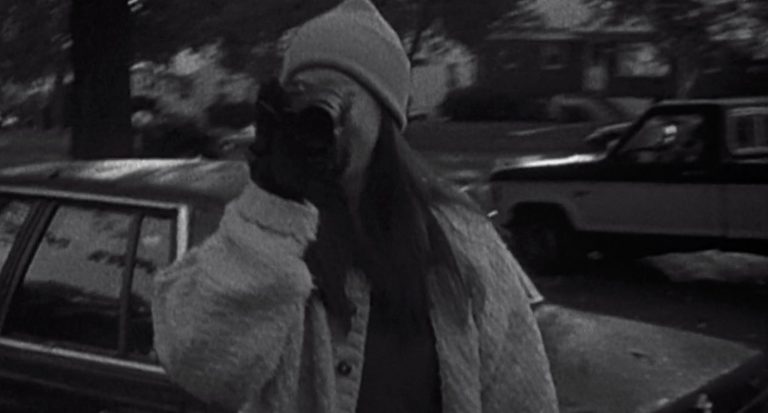
Heather Donahue, Michael Williams, Joshua Leonard
The three protagonists in The Blair Witch Project slowly break down throughout the film. The mental anguish you see on screen reflects the torment they were being put through at the time by directors Daniel Myrick and Eduardo Sánchez, who forced them into a constant state of fear and anxiety. The cast was given a GPS programmed with coordinates of different locations and left to shoot on their own, with extremely little interaction with the crew. They were required to remain in character throughout the entire shoot. Over the course of those eight days, the directors would terrorize them at night, playing eerie recordings of children and rattling their tents.
Myrick has said, “If we’ve physically and mentally abused them enough in the process of getting them up to those intense moments at the end, then they’d be able to tap into emotional places that they wouldn’t otherwise be able to tap into. We did keep them isolated, we harassed them at night, we deprived them of sleep, we made them move a lot during the day. Then at the end, we slowly fed them less and less, and they never knew what was happening. They were always off-balance.” One of the more traumatic experiences for Donahue was people actually thinking she was dead, she shared in an article she wrote for The Guardian. It’s infuriating to know that the cast was exploited and never properly compensated for their work. The movie would have never had its success without them.
It (2017)

Bill Skarsgård
It’s interdimensional demonic alien clown will haunt children and adults for generations, as well as the actor who played him. Getting into the mind of Pennywise had lasting effects on Bill Skarsgård’s psyche. In a conversation with Entertainment Weekly, he likened the time spent playing the killer clown to being in a “destructive relationship.” Skarsgård shared that even after wrapping production, he was plagued by “very strange and vivid Pennywise dreams” at night. “Everything I did took 100 percent of my energy. It was by far the most exhausting character I’ve ever done, physically and mentally,” he shared with The New York Times.
Hereditary (2018)

Alex Wolff
To describe Hereditary as disturbing would be an understatement. There are no words in the English dictionary to encapsulate the experience of watching Ari Aster’s dark masterpiece. It wasn’t just the audience who was overwhelmed and deeply affected by the horror film. Alex Wolff has been open about the trauma involved in playing Peter Graham, which went as far as causing him memory loss.
He told Vice that the film stuck with him long after filming: “When I started talking about it, all these flashes with all this disturbing shit I went through sorta came back in a flood. It kept me up at night to where I got into a habit of emotional masochism at that point of just trying to take in every negative feeling I could draw from. I forced it upon myself rather than the opposite of what you’d usually do in life, which is sit on the heater until it starts to burn and you jump up immediately. I had to do the exact opposite of that and absorb the pain and let it burn. It’s a reverse emotional thing. It’s hard to describe eloquently, it’s just a feeling. I don’t think you can go through something like this and not have some sort of PTSD afterwards.”
See also: The Most Disturbing Scene in ‘Hereditary’
Midsommar (2019)
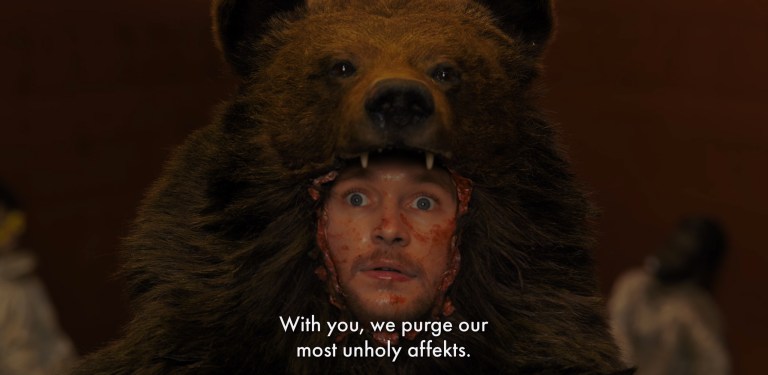
Actor: Jack Reynor
In a candid interview with Collider, Jack Reynor opened up about the psychological toll he experienced while shooting Midsommar: “People don’t give actors enough credit for the emotional and physical damage they can take on a set.” In regards to his wild ritualistic sex scene, he said, “It was nerve-racking, and it did feel very expositional. It made me feel more vulnerable than I anticipated I would feel.” Reynor described filming the bear scene as “dark and unsettling,” claiming that it was heavy to watch the crew make it look like he was about to be horrifically sacrificed. The experience weighed on him so much that he immediately went to the airport and got hammered: “I basically went from the set to the airport and I got f**king smashed…I said, ‘Send me on two flights home, don’t send me direct, I want to transfer, because I’m going to get even more f**king hammered.”
Further reading:
